
Schwalbe’s Procore System
I love running low pressure! It gives you great traction in every situation and an added level of small bump compliance.
I hate low pressure. Your tire deflects making steering imprecise, you are more likely to burp with tubeless or pinch with tubes and your suspension is slow to react, creating a spike and compromising small to medium-sized bump compliance. Low pressure feels great and feels awful at the same time.
Schwalbe thinks their Procore system gives all the advantages of high and low pressure tires while improving flat resistance despite allowing you to run a lighter tire than you might normally choose.
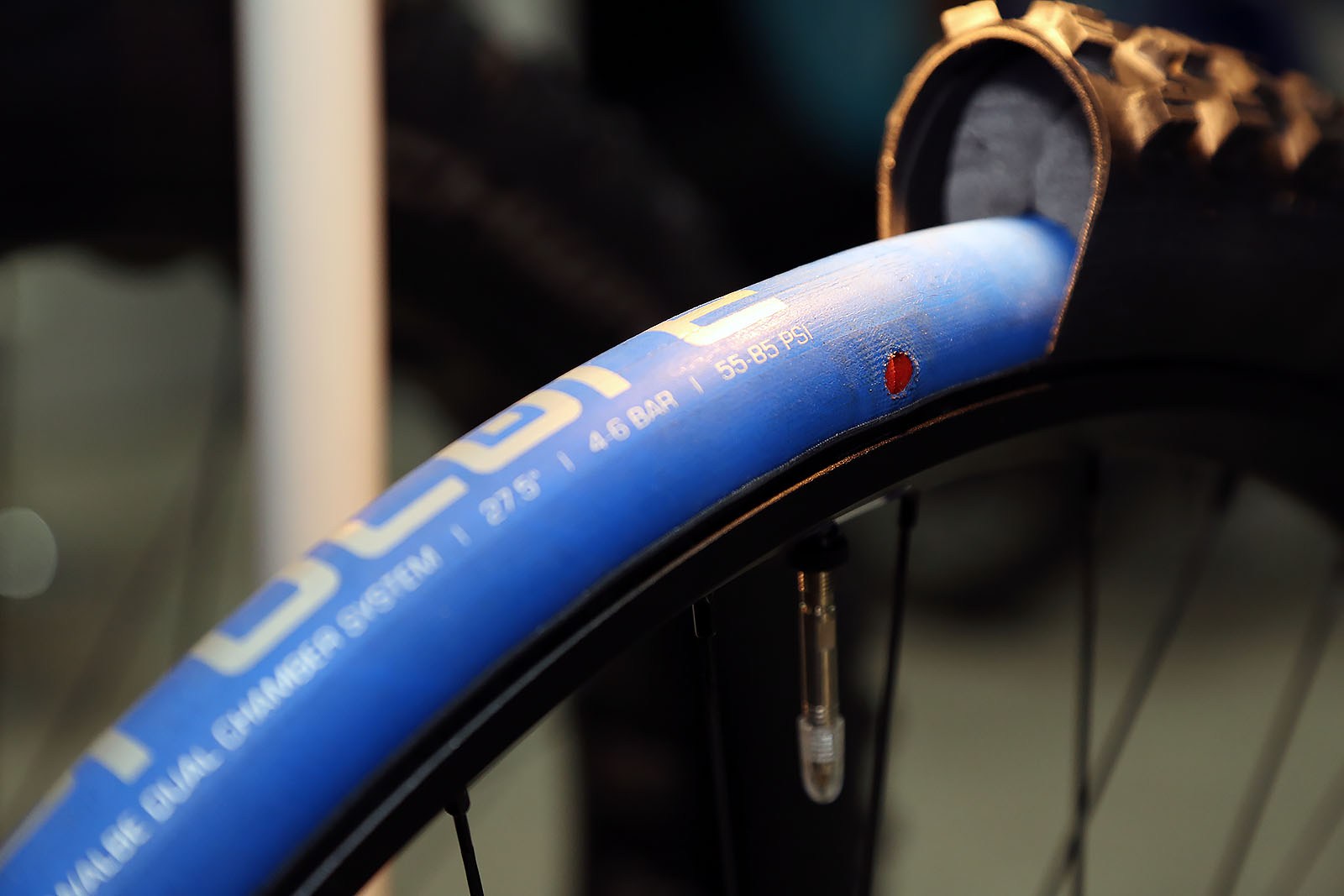
A tire and a tube within your tubeless tire? If it does all it claims it’s hard to imagine any serious rider going without it.
Procore debuted earlier in 2014 but it was shown as a dual valve system, necessitating a second drilling. Now the system can be filled from a single presta valve that inflates the inner and outer tires independently.
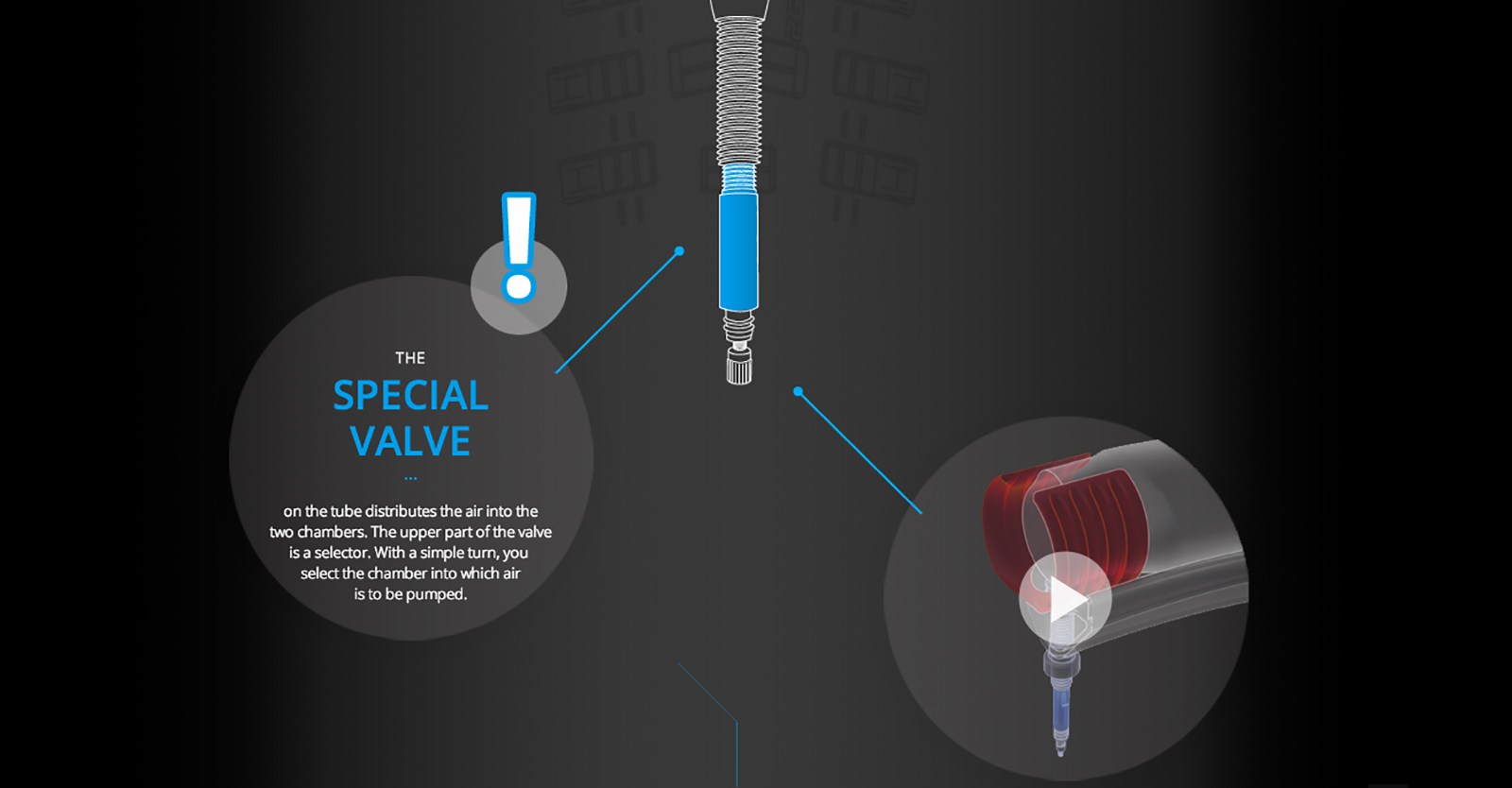
Early iterations of Procore relied upon two valves. A little time back at the drawing board helped the engineers devise an inflation system to inflate the core and the outer tire independently using only one valve.
Procore was co-developed by Schwalbe and Syntace. The idea began with Syntace founder Jo Klieber as a way to allow your suspension to initiate before your tire bottoms out on the rim. This should mean better suspension performance in general and improved response for small to medium sized impacts. To achieve that Klieber envisioned a high pressure core inside your tubeless tire to allow the response of the tire to react in a more progressive fashion to an impact.
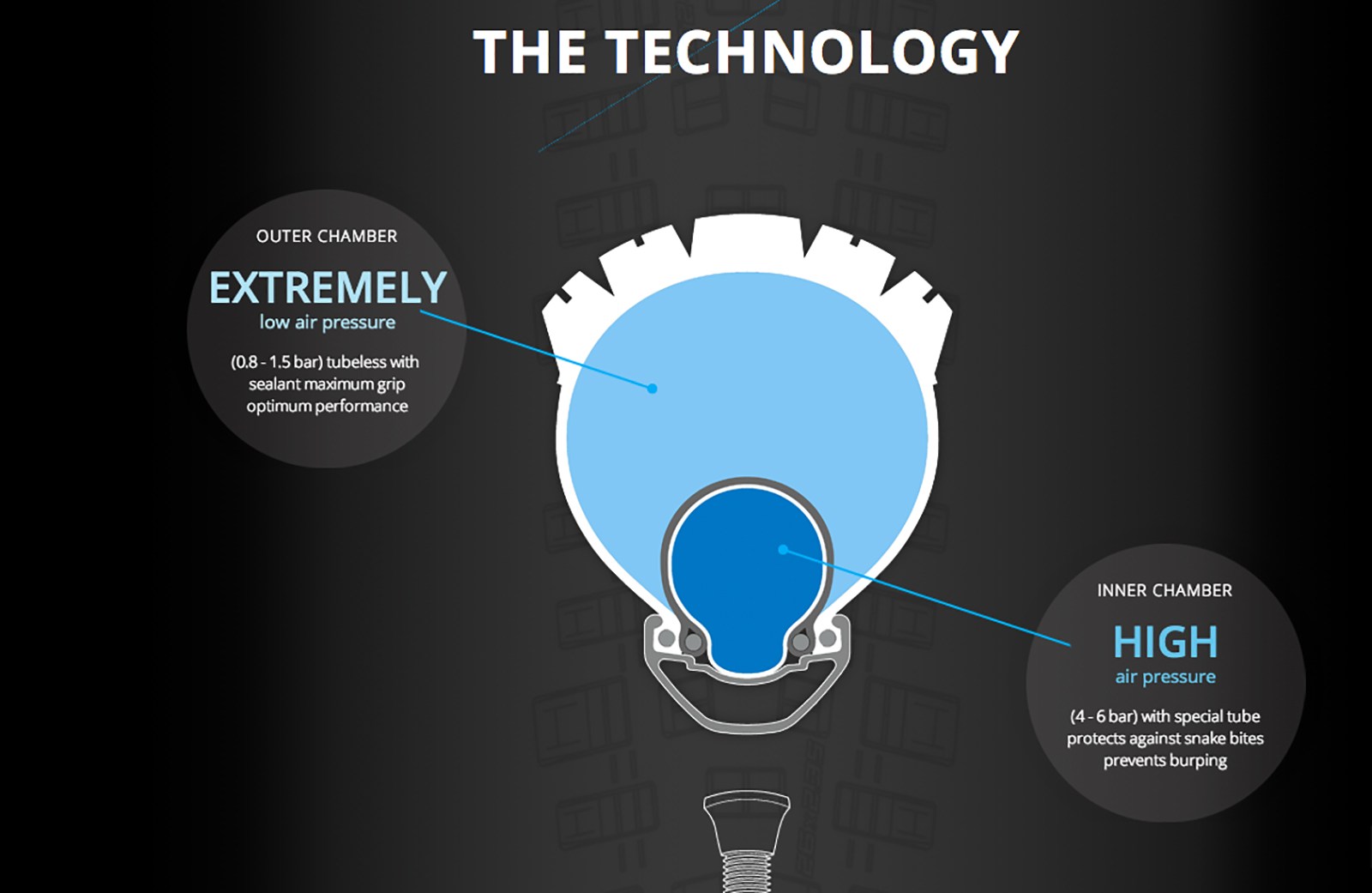
Not just low but EXTREMELY low pressure. Down to 10 PSI. I’m curious about just how low I will end up going.
How does it work?
The core looks a lot like a road tire and it mounts inside your tubeless tire, but it’s not tubeless within tubeless. The inner tire requires a tube with the proprietary dual valve. The recommended pressure range for the core is from 58-87 psi (4 to 6 bar). The high pressure inner tire locks the outer tire’s bead to your rim which, according to Schwalbe, should eliminate burping. Another advantage is that the inner core allows you to run lower pressure in the outer tire for increased traction and small bump compliance, but without any of the usual low pressure disadvantages. Outer tire suggested range is 11.5 to 21.7 psi (0.8 – 1.5 bar).
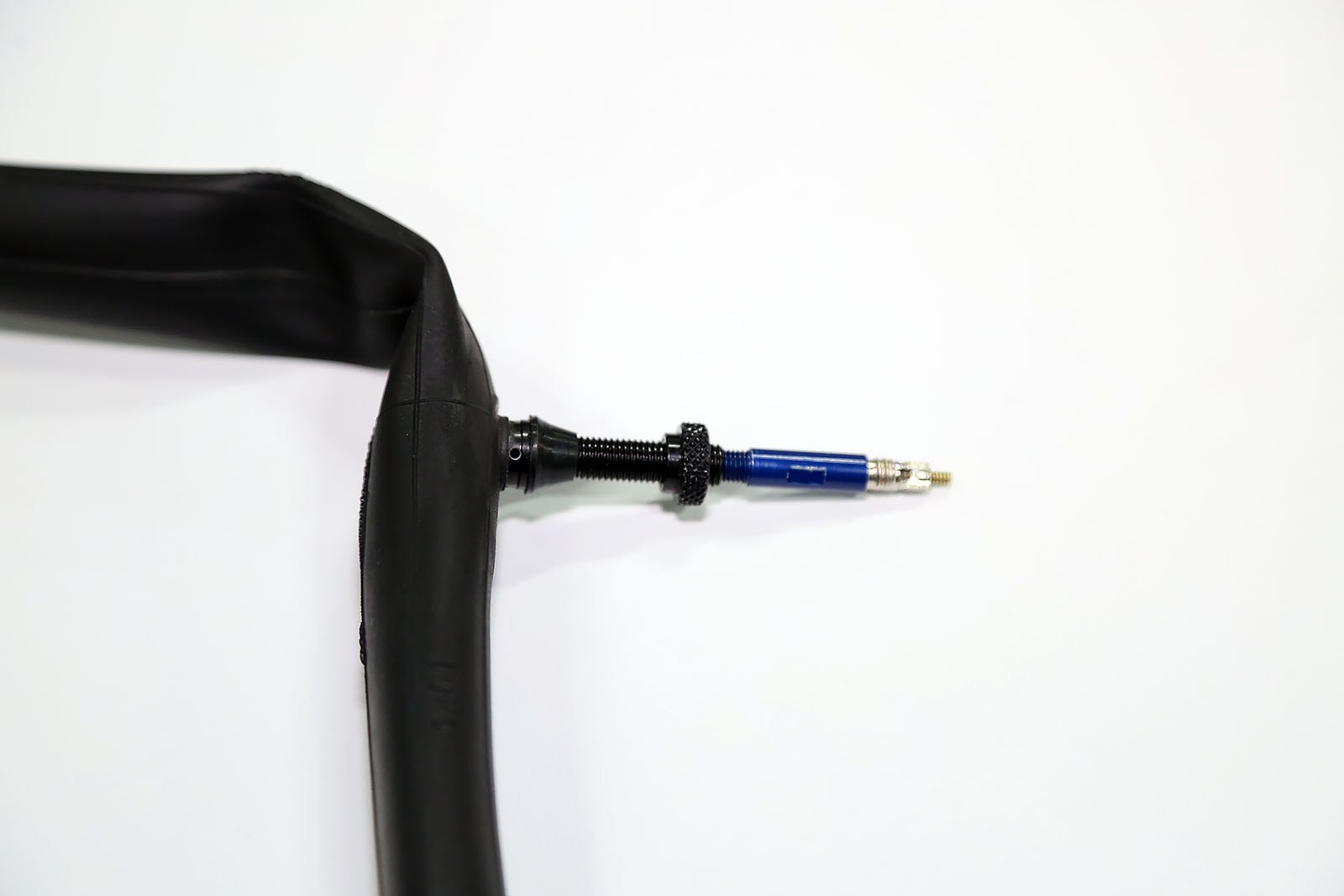
To operate the single valve, dual inflation system, you simply turn the blue cylinder to select either the inner or outer tire.
Other advantages
Schwalbe tells us you can continue to ride the system if you lose pressure in the outer tire, allowing racers to finish their event, and the rest of us to get home without a repair. The high pressure core should also protect your rim from dents and, as mentioned earlier, enhance suspension response and performance.
The system weighs 200 grams per wheel but it should allow you to use a lighter tire, erasing some if not all of that deficit. It also costs money sadly. The Procore kit for two wheels includes everything you need for the conversion including sealant for the inner tire, special tire levers for the install, inner tires, dual valves and rim tape. You’ll still need outer tires of course, and the system will work with any tubeless tire and rim combo as long as the rim is at least 23mm wide. Eventually individual components will be sold in case you need to replace only a part of the system.
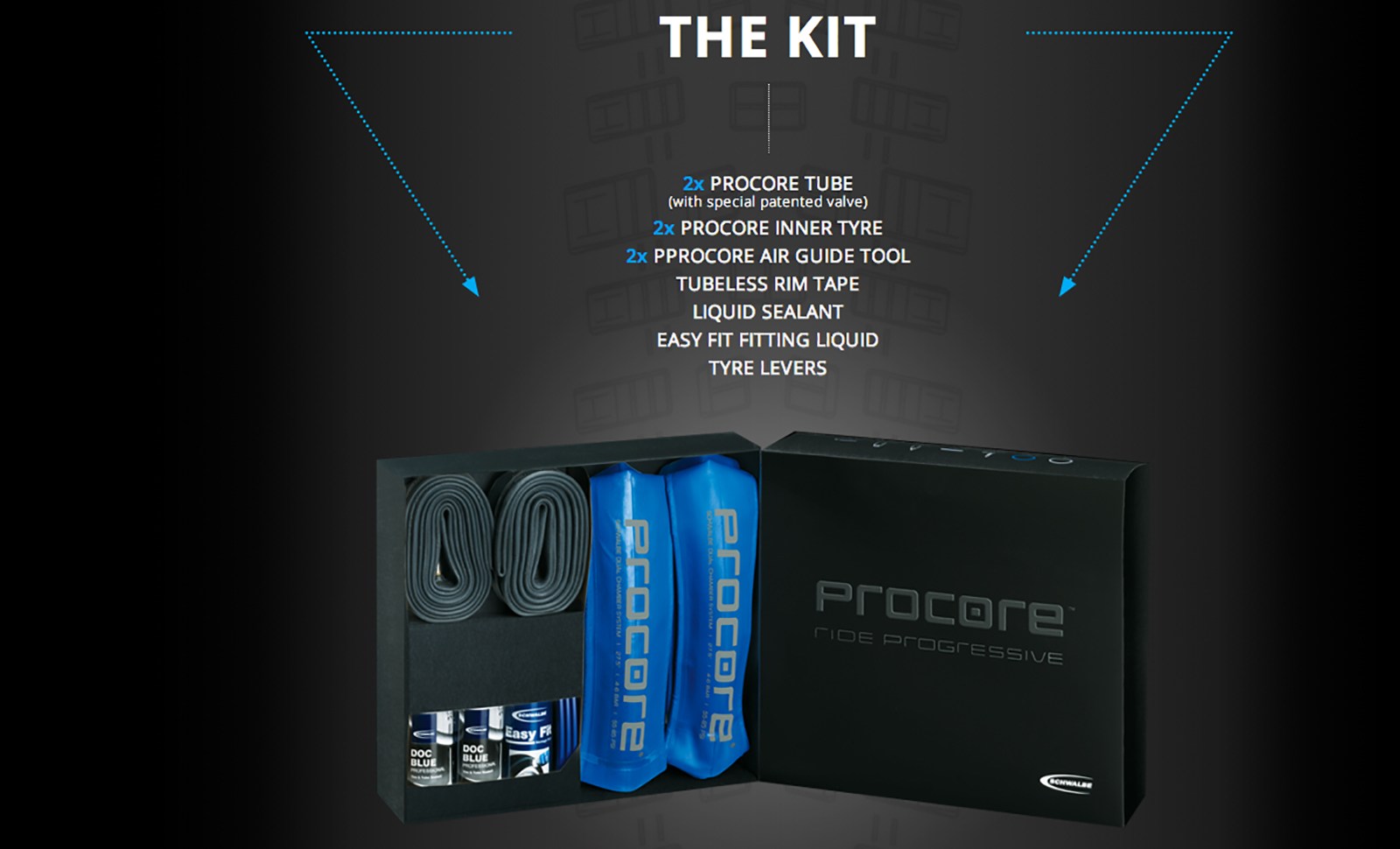
Schwalbe hopes to have Procore in shops by December in all three major wheel sizes. The US price is said to be in the neighbourhood of $200 and £180 in the UK. No word yet on Canadian pricing.
If the Procore system does everything it purports to do I will be the first in line to convert my bikes. You?







Comments
The Big Picture
9 years, 2 months ago
I don't see an advantage. I run 18 psi rear tire and 10 psi front tire,
with 33mm inside width front rim and 21mm inside width rear rims. I get
away with a 530g 2.4 rocket ron rear and 750g 2.4 hansdampf or 800g 2.4
trail-king, on the fronts. I just don't see these catching on. Why have a
200 gram weight penalty, per wheel. As far as flat protection goes.
With tubeless ready tires and Stan's sealant. I just don't get flats,
ever. My riding weight, pack and all is around 210 lbs. My wife's riding
weight is closer to 115. She uses even less psi. 10 front and 15 rear.
Reply
Morgan Taylor
9 years, 7 months ago
The idea makes sense but I've got to echo the concerns about the way a standard tire feels (folding and rolling) when cornering hard at lower pressures. With some volume taken up by the Procore inner tire the effective spring rate of the tire could be more progressive, lessening this effect. I'm interested to see how it pans out.
Reply
Derp
9 years, 7 months ago
All of my flats lately (4 this year) have been because of slices through the tire. So even with Procore, I'm still riding out on what is essentially a flat tire, and then, I would have to patch the inside of the tire like I would normally. Using thinner tires is not really an option because of this.
The only real benefit to this system is to prevent pinch flats through the tire, which if you are running proper amount of pressure is a non issue anyway. Using too low pressure and your tires get squirmy, so I'd still want to run my normal pressures. Plus, the obvious rotational weight your wheels will gain, and that would be quite noticeable.
I'm trying to see the benefit of this system. Just like the moto version, I think its a gimmick.
Reply
Cam McRae
9 years, 7 months ago
You don't see the benefit of more progressive feedback for the fork and shock? How about added traction? One of the reasons I'm less skeptical is because I have spoken to people I respect who have ridden the system, but independent of that I see myself benefitting if it works as advertised. You also may ride in an area where there is little advantage to riding lower pressure.
Reply
Derp
9 years, 7 months ago
The suspension (and therefore handling) works best when there is relatively a lot of pressure in your tires. I don't see how the Procore system would help that.
If you ride in an area where it is very technical and very slow, when using lower pressure is not a hindrance, then there could be some benefit. But I guess we're talking walking speed? Higher speed trails where you need high pressure, I see virtually no advantage to using this system. Unless you don't like carry a tube and a pump with you.
I was the first person in Canada to test Nuetec's TuBliss system for dirtbikes. The same basic principles apply - it prevented pinch flats, but it did nothing for when I'd slice the tire on a rock. Plus, I had to run normal pressures to keep the bike's handling 'normal'. When it worked, it worked as advertised, but there were too many issues with no real advantages to make me want to keep using it. This Procore system is almost identical. The needs of mtb riding are the same.
The best way to eliminate flats completely is by running some sort of a mousse or inflatable tire balls. If tire manufacturers could develop such systems that were extremely light, THAT would be the game changer.
I have been saying this for years - tire manufacturers need to develop a better hook/bead system that really locks the tire onto the rim. More than what is currently on the market. Stan's system is good, but there could be better. Plus, the area of the tire near the bead should be thicker. From my experience, the best way to prevent flats while keeping good handling under low pressures is by using thicker tires. I'm not talking Intense 4 ply tires, but something that has had some thought put into it.
Reply
Cam McRae
9 years, 7 months ago
Please note that I never said 'game-changer.' Nevereverever!
If you read my article, and perhaps you did not, you would know that the initial motivation for developing the system was to improve suspension response by providing a more progressive compression of the tire in response to impact, thus initiating the suspension more efficiently without having to crank the pressure beyond that which gives you good traction as well as efficient roll over and trail feel. It also may be that a lower pressure outer tire is less susceptible to tears and cuts because it will deform more - but that remains to be seen.
In terms of bead lock, have you ridden a hookless bead rim like the new Enve, Ibis or Specialized products? The bead lock is ridiculous. Particularly the Enves.
Reply
Derp
9 years, 7 months ago
I haven't used those rims yet, but in particular I am referring more towards tires rather than rims. The design is in my head, not sure if I can explain it. lol!
Reply
AndrewR
9 years, 7 months ago
Cam, there are always going to be those that "get" tubeless (through trying a variety of tyres, pressures and suspension settings, preferably on the same set of trails) and those that don't or don't want to put in the time to find out how good tubeless can be. Michelin Comp 16s on Mavic 823s in 2002 (were called something else back then) at 22 psi (for a 200 lbs rider) was the wake up call. Tubeless for 12 years and as far as I can see this ProCore can only be a "value add". Oh and I do run tubeless on ENVE (for two seasons now, 180 ish six hour days) and recommend Conti Kaiser Projeckt or Trail Kings with 30 rear/ 27 front psi for jumping (think A-Line) and 27 rear/ 24 front psi for tech trails.
Reply
Jay M
9 years, 6 months ago
Essentially flat but not flat, the bike being rideable still is a huge plus. Besides the ability to run lower pressures will reduce the likelihood of tearing through/ puncturing the tire.
Reply
Joseph707
9 years, 7 months ago
I've been following this since it was a proto design … 200$ sounds like but compare it to the price of one rim or a major crash because a pinched tube / blown seal … really cheap insurance and likely huge performance gains
Reply
Joshua Fultz-veinotte
9 years, 7 months ago
yea an , i can safely run carbon rims now
Reply
Pete Roggeman
9 years, 7 months ago
I have a feeling this is going to be a popular stocking stuffer for the rider in everyone's life.
Reply
Kyle Doherty
9 years, 7 months ago
I wonder if the future is a lighter tubeless procore type system (only the blue part) with some UST type bead locking into an inner channel on the rim. I'll wait and let others be the guinea pig on the first gen stuff.
Reply
Cam McRae
9 years, 7 months ago
It would be interesting to see if some sort of interface between the inner and out tires could make the system lighter without compromising effectiveness. But we're getting ahead of ourselves since we haven't even had a chance to ride this generation. We have that lined up so hopefully we'll get some time on Procore soon.
Reply
Please log in to leave a comment.